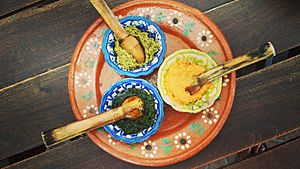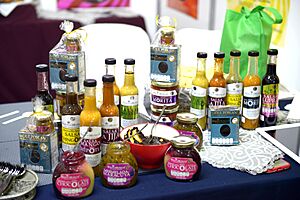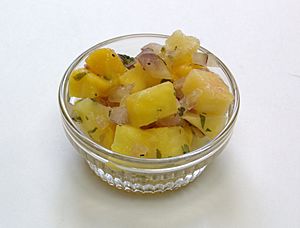Salsa (Mexican cuisine) facts for kids

A variety of salsas
|
|
| Type | Condiment |
|---|---|
| Region or state | Mexico |
| Main ingredients | Varies |
Salsa is a popular sauce used in Mexican and Mexican-American meals. It's often served with tacos and other dishes. You might also know it as a dip for tortilla chips. Salsas can be made fresh or cooked. They are usually served at room temperature.
The word salsa means "sauce" in Spanish. But in English, it usually means these special Mexican table sauces. Some common types are pico de gallo, which is chunky and made with tomatoes and chili peppers, and salsa verde.
You'll often find tortilla chips with salsa as a starter in Mexican-American restaurants. However, this is not as common in Mexico itself.
A dish of sauce or relish is as indispensable to the Mexican table as our salt, pepper, and mustard.
Did you know that Syrian Jews in Mexico sometimes mix the Middle Eastern dish kibbeh with salsa verde? It's a cool blend of cultures!
The Story of Salsa
Salsa became very popular as a table dip thanks to Mexican restaurants in the United States. In the 1980s, tomato-based Mexican-style salsas grew a lot in popularity.
Some people who love salsa think that jarred salsas aren't the "real thing" compared to fresh ones. But these jarred salsas are easy to find and last a long time. This has helped salsa become super popular in many places, especially where it wasn't a traditional food. In 1992, the money spent on salsa in the United States was even more than what was spent on tomato ketchup!
Later, new kinds of salsas appeared. These were made with fruits, corn, or black beans. Since the 2000s, sweet salsas have become popular. These combine fruits with spicy peppers like habanero, Scotch bonnet, and datil. They are even served with desserts like cheesecakes!
In the United States, salsa is used in many ways. It can be a marinade for meat, a salad dressing, or added to stews and cooked sauces. Besides being served with fish, chicken, and meat, it's also a tasty topping for baked potatoes, pasta, and pizza.
Different Kinds of Salsa

Salsa is a key part of Mexican cuisine. It's served as a condiment with tacos, stirred into soups, or used as a filling for tamales.
- Salsa fresca is a fresh salsa. It's made with tomatoes and hot peppers.
- Salsa verde is made with cooked tomatillos. It's often used as a dip or a sauce for dishes like chilaquiles and enchiladas.
- Chiltomate is a common base sauce. It's made from tomatoes and chiles. The type of pepper used changes depending on the region. For example, fresh green chiles are more common than habanero in Chiapas.
Tamales are often named by the type of salsa they are filled with. Some examples are salsa verde, salsa roja, salsa de rajas, or salsa de mole.
Traditionally, Mexican salsas were made using a molcajete. This is like a mortar and pestle. Today, blenders are also used.
Here are some common Mexican salsas:
- Salsa roja: This is one of the most common types. It means "red sauce." It's used in Mexican and Southwestern (U.S.) cooking. It usually has cooked tomatoes, chili peppers, onion, garlic, and fresh cilantro.
- Salsa cruda: This means "raw sauce." It's an uncooked mix of chopped tomatoes, onions, jalapeño chilies, and cilantro.
Jarred Salsas
The fact that jarred salsa is easy to find and lasts a long time has made it very popular. This is especially true in places outside the Southwest United States, where salsa isn't a traditional food. In 1992, the money spent on salsa in the United States was more than what was spent on tomato ketchup.
Keeping Salsa Safe
The WHO says it's important to prepare and store salsa carefully. This is because many fresh salsas can allow harmful bacteria to grow, especially if they are not kept cold.
Studies have shown that salsa can sometimes have bacteria like E. coli. For example, a 2002 study found this in salsas from restaurants in Guadalajara, Mexico, and Houston, Texas.
In 2010, the CDC reported that some foodborne illnesses were linked to restaurant sauces that were not prepared or stored properly.
To keep salsa safe, refrigeration is very important. A 2010 study also found that fresh lime juice and fresh garlic (but not powdered garlic) can help stop the growth of harmful bacteria like Salmonella.
See also
 In Spanish: Salsas de la gastronomía mexicana para niños
In Spanish: Salsas de la gastronomía mexicana para niños




